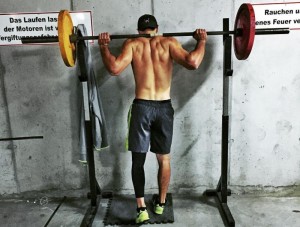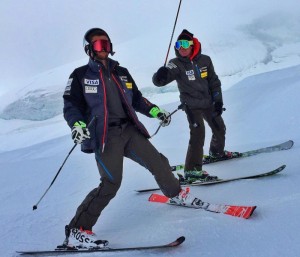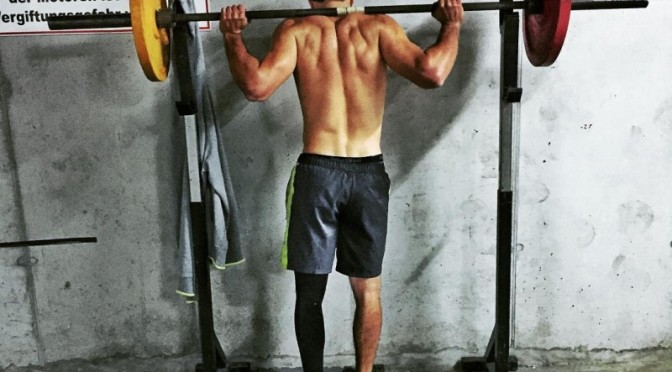Keene, NY – Try telling an alpine ski racer who specializes in speed to move slowly. It’s not easy. Tommy “BZ” Biesemeyer, of Keene in New York State’s Adirondack Mountains, is no exception. After sustaining an ACL and MCL knee injury in 2014, Biesemeyer had to come to terms with the fact that he had pain that never really went away. Now, Biesemeyer has done the work and put in the time the right way: by moving slowly.
For someone who is accustomed to reaching skiing speeds upwards of 90 m.p.h., a slow return-to-snow progression can be mentally tough to handle. But Biesemeyer is taking it all in stride and keeping things in perspective. He’s been putting in countless hours in at the U.S. Ski Team’s Center of Excellence gym in Park City, Utah, with teammate Ryan Cochran-Siegle under Strength and Conditioning Coach Tracy Fober.
“This summer I felt really good, and I felt strong,” Biesemeyer said. “But at the same time, mentally I had this cloud of doubt that just sort of lingers with you…just because of my previous experience with injury.”
It’s hard to understand the strength it takes to come back from an injury—not only to physically get your body in shape, but to also get your mind to where it needs to be in order to hurl yourself down a mountain at speeds faster than an automobile. It requires an athlete to dig deep and have extreme grit.

Sure, Biesemeyer is strong physically, but he’s quick to note that in order to be a ski racer, you need to ski. “I know that being strong physically doesn’t necessarily mean that I’m in a good position to have a good ski season,” said Biesemeyer. “If my knee feels good on snow, then I think I’ll be ready.”
Biesemeyer is currently working with coach Bernd Brunner and an all-star team composed of physio Bill McCormick and fellow previously injured teammates Resi Stiegler and Cochran-Siegle. As the rest of the U.S. Ski Team athletes traveled to the Southern Hemisphere to ski in Chile in September, these three headed in the opposite direction to Saas-Fee, Switzerland. Stepping from the gym back to the corduroy was an unknown for the crew. How would they feel? Would their knees be ready to sustain the demands of the sport?
Looking back on his first return-to-snow camp, Biesemeyer feels positive. He believes he can now work on his skiing and not focus on pain-management skiing. “That’s a real step forward for me,” Biesemeyer said with relief. “Now it’s just working through the process and getting back into preparing for the race season and having no hiccups. I have to keep moving forward, even if it’s slowly.”

Moving slowly is easier to swallow when working with Bernd Brunner, who is a former promising Austrian World Cup ski racer who has been through it all before. The athletes love working with him, and also because of Brunner’s experience, they take what he says seriously.
“He was winning Europa Cups when he was 17 years old, but he had a series of knee injuries that kept him from ski racing,” reflects Biesemeyer. “He personally can relate to coming back from injury and having knee pain. It’s nice to have a coach that can relate to our situation.”
Doing drills for five hours a day is rough for Biesemeyer. “But, for Bernd, I think that’s something he realizes he should have done when he was coming back from injury,” said Biesemeyer. “So, I think he’s using us as a way to fix what he didn’t do when he was racing. And I think that’s really valuable for us.”
Brunner weighed in about the importance of finding the right mix of mental and physical grit, and setting realistic goals in a return-to-snow season. “You have to be patient, and that’s hard especially when you see your teammates and racers from all over the world skiing and training,” he noted. “It’s really important to set one big goal for yourself. Our team’s goal is to compete at World Cup Finals in St. Moritz and to be competitive.” But in the meantime, it’s all about smaller goals—goals for every week, every month, every camp.
And that’s what Biesemeyer, Stiegler and Cochran-Siegle are doing. They’re working as a team to create realistic goals, while having fun and respecting where each other is in their physical and mental healing process. Biesemeyer believes working with his two colleagues is great for all of them because they have a common understanding.
“If we have knee pain, we have a tough day where it hurts, there’s no judgment. There’s no criticism,” said Biesemeyer. “And I think that’s part of the mental process in coming back from injury…in taking it slow and taking it easy, those are the days that are hard. And Bernd is great in that sense. He doesn’t really stress about it.” Biesemeyer notes the importance of throwing the whole ‘no pain, no gain’ mentality out the window in their case. There’s a time and a place for that, and it’s the wrong approach for these three.
All three are currently in Soelden, Austria, progressing from free skiing to gates, slowly working into higher intensity training. And they’ve got a new look, as teammate Erik Arvidsson has joined the crew.From there, they’ll have some time off before heading to Copper Mountain to kick off the season in Colorado. Biesemeyer hopes to be back in World Cup action for Lake Louise. When asked about his season goal, Steven Nyman entered the room and answered the question for Biesemeyer: “TO SKI WITH STEVEN!” Biesemeyer laughed and replied, “I’m most looking forward to kicking Steven’s ass!”
In all seriousness, Biesemeyer looks forward to being in the heart of it again. The #AmericanDownhiller crew has a great team vibe and the energy and competitive spirit they foster is contagious. “I think I’m excited to feel the nervous energy again, and to try to win,” said Biesemeyer. “That’s what everyone is there trying to do. That’s what makes it fun and competitive. And that’s what makes it frustrating.”
The time off wasn’t so bad for Biesemeyer. He was able to acknowledge that ski racing isn’t everything in life, and made new friends while working on a college degree at University of Vermont—all which made him appreciate skiing in a bigger way. Brunner encouraged Biesemeyer to explore life outside of skiing.
“It’s important to accept the injury and to become stronger, but it’s equally important to try to take something positive out of it and to not take things for granted and see the bigger picture,” Brunner emphasized. “You should work hard and live your dream, but if that dream doesn’t come true, there is plenty of interesting, fulfilling stuff out there.”

